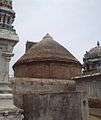Palaivananathar Temple
| Palaivananathar Temple | |
|---|---|
|
| |
 Palaivananathar Temple Location in Tamil Nadu | |
| Name | |
| Other names | Tirupalathurai |
| Geography | |
| Coordinates | 10°56′N 79°17′E / 10.933°N 79.283°ECoordinates: 10°56′N 79°17′E / 10.933°N 79.283°E |
| Country | India |
| State | Tamil Nadu |
| District | Tanjore |
| Location | Papanasam |
| Culture | |
| Primary deity |
Palaivananathar (Shiva) |
| Consort |
Dhavala Vennakaimangai (Parvati) |
| Architecture | |
| Architectural styles | Dravidian architecture |
Palaivananathar Temple is a Hindu temple dedicated to Lord Shiva located in Papanasam, Tamil Nadu, India.[1] It is a Paadal Petra Sthalam and is considered to be the 19th in the series of Thevara Stalams in the Chola kingdom located south of the river Kaveri.
The Temple
The Thirupalaithurai temple with 2 prakarams(outer courtyard) occupies an area of 3 acres (12,000 m2), and its entrance is crowned with a 5 tiered Rajagopuram. Inscriptions from the Chola and Vijayanagara Empire periods are seen in this temple. Here Lord Shiva is also known as Paalaivananathar.
Granary
There is also a world-famous granary[2] (Store House of paddy) Breadth: 86 feet (26 m), Height: 36 feet (11 m) capacity of 3,000 Kalam (measure) constructed by Nayaks in 1600 - 1634. State Archaeological Department declared it as a monument. Mention must be made of those from the period of Kulothunga Chola I and Kulothunga Chola III speaking of gifts made to the temple during the Chola period.[3]
Papanasam
Papanasam (Thanjavur) (Tamil: பாபநாசம், literally means Destruction of Sins) is a panchayat town in Thanjavur district in the Indian state of Tamil Nadu. In otherwords it is a grown up village and Growing Town. This is the town 25 km from Tanjore and 15 km from Kumbakonam. There are 3 rivers named Kaveri, Thirumalairajan and Kudamurutti helping the farmers to cultivate the good food – grains.
Gallery
 Granary
Granary- Palaivananathar Temple Tower
References
- ↑ Census of India, 1961, Volume 7; Volume 9
- ↑ "A comprehensive list of Chola inscriptions, Archaeological Survey of India". whatisindia.com. Retrieved 16 July 2011.
- ↑ "What to see - Thanjavur district attractions". Thanjavur District Administration. Retrieved 2013-07-07.
- S. R. Balasubrahmanyam; B. Natarajan; Balasubrahmanyan Ramachandran. Later Chola Temples: Kulottunga I to Rajendra III (A.D. 1070-1280), Parts 1070-1280. Mudgala Trust. p. 127.

